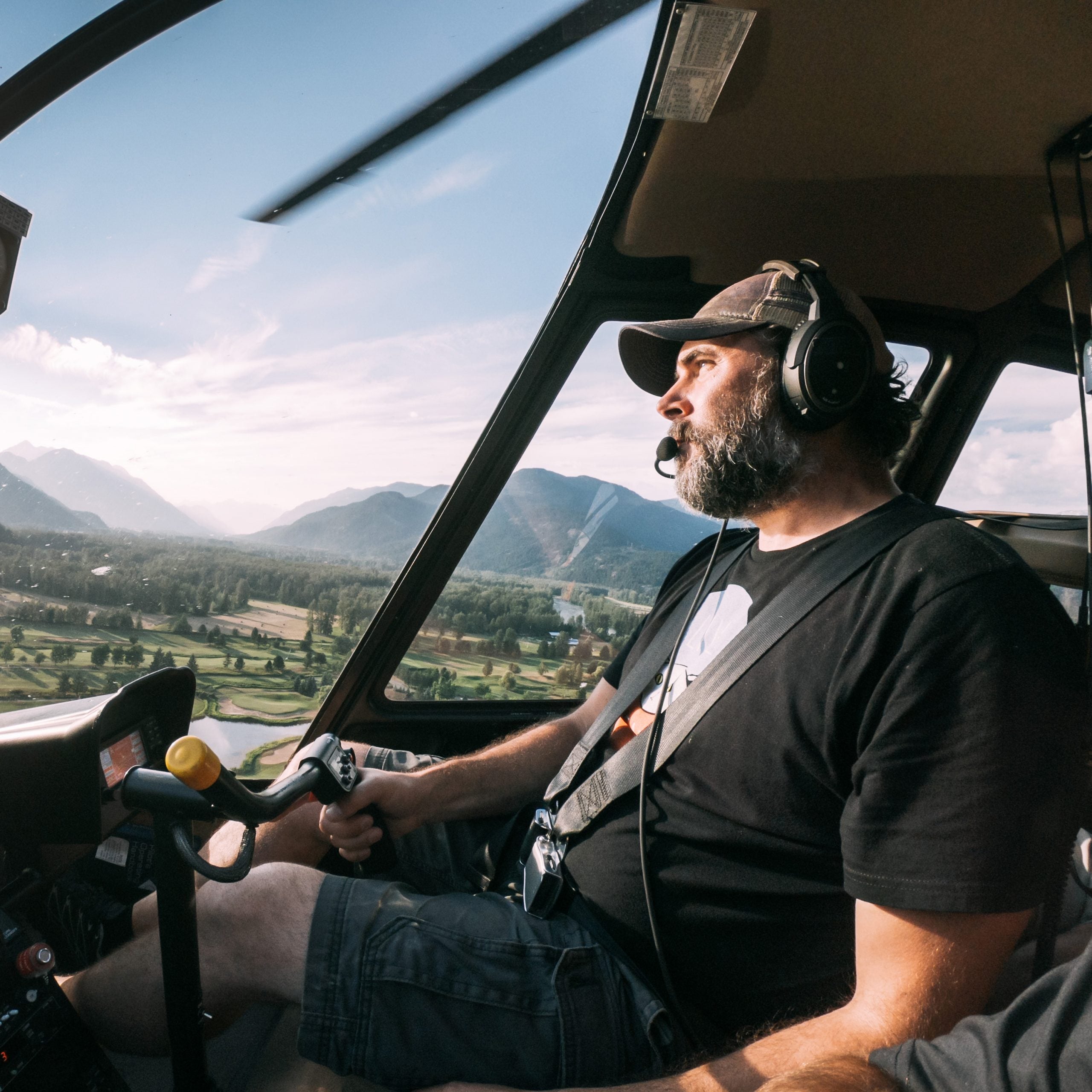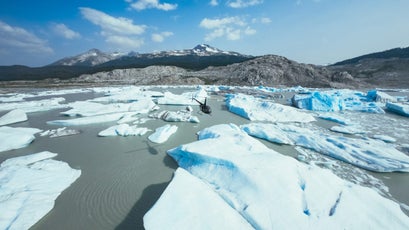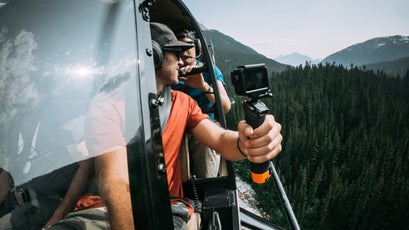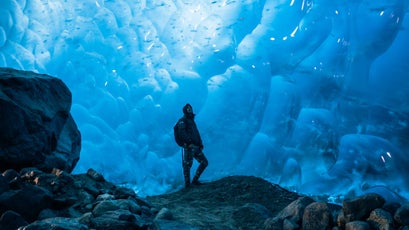Videographer and adventurer Bradley Friesen‚Äôs chief passion is flying helicopters, but he‚Äôs just as well known for his aerial photography. His popular ¬Ýis filled with heli-biking trips, ice biking races, and some of the most beautiful shots of British Columbia ever captured on video. There‚Äôs also a lot of Mister Bentley, Friesen‚Äôs beloved (and fist-bumping) English boxer, who often flies with Friesen and is the star of his own very popular . Earlier this year, to test out the new , Friesen took a few members of the company‚Äôs production team¬Ýon a tour of a remote ice cave on the Pemberton Glacier he‚Äôd been wanting to film. Afterward, we caught up with him about how he became a pilot, why dogs really are the best copilots, and what he thought of the new camera.
It Started with Toilet Paper Dispensers
Friesen has a no-holds-barred approach when it comes to the pursuit of dreams. He got his helicopter pilot license at age 18. And later Friesen and his two entrepreneurial brothers bought an injection plastic plant. The primary moneymaker? Toilet paper dispensers. ‚ÄúI was the Ass-Wipe King,‚Äù says Friesen. The three brothers sold that business in 2009, and Friesen used the proceeds to buy an affordable helicopter to fly recreationally. Here‚Äôs the takeaway: Just because your day job isn’t sexy doesn’t mean you can‚Äôt parlay that work into the life you want to live.
Flip the Script
One day Friesen was flying around in the high peaks and spotted a rarity: a perfectly frozen, black-ice lake unblemished by early season snow. A few days later Friesen airlifted two NHL skating coaches to the location. ‚ÄúThey played hockey as I shot from the helicopter,‚Äù says Friesen. The footage from that day went viral, because it was epic‚Äîbut also because it was so unexpected; placing athletes in new places is eye-catching. Keep that in mind next time you‚Äôre out shooting with your friends. And when your buddy asks if he should ski through town or surf a standing wave in a whitewater stream, your answer should always be “Yes.”
Location, Location, Location
Friesen has been scouting the big peaks and glaciers outside of Pemberton for years. One of his favorite spots? A massive ice cave at the toe of the Pemberton Glacier. From a few thousand feet up, it looks like a tiny dot in a sea of white. Up close, it’s pure majesty, with sunlight penetrating blue glacial ice from above and direct sun scattering light throughout the cave entrance from below. Friesen visited the cave frequently, and it never looked the same twice. When the GoPro video team said they wanted to capture ice cave footage, Friesen knew just the place. “It’s literally the coolest place I’ve ever seen in my life,” he says. “As the snowpack thins in spring it turns a thousand shades of blue. There’s a two-story tall rock inside, but it’s dwarfed by the scale of the cave. It’s like the Fortress of Solitude.”
Say Goodbye to Jello
Think a rocky section of singletrack shakes a camera? Try mounting one to a helicopter. In the past, the only way to overcome that amount of vibration was with an IMAX-quality external gyroscopic stabilizer, or you gambled and mounted the camera directly to the frame of the helicopter knowing that much of the footage would be worthless. Friesen‚Äôs smaller recreational helicopter wouldn‚Äôt accommodate the heavy gyroscope anyway, so he made do with the direct mount, and still produced web footage adored by thousands of followers. ‚ÄúWith HyperSmooth,‚Äù says Friesen of the¬ÝHERO7 Black¬Ýfeature the crew team was experimenting with on the way to the ice cave shoot, “there‚Äôs no jello,‚Äù meaning that wavy distortion that makes it look like you‚Äôre underwater. ‚ÄúNo shake. It will forever change time-lapse shoots for me.‚Äù
There’s Always a New Angle
Friesen doesn’t call himself a videographer, but he’s picked up a lot of tips in flying videographers around the Canadian high country. One of the best is to mix up the perspective. In the cave, Friesen watched as the GoPro videographers and producers worked their magic. To get the footage for the Ice Caves video above, they used a race drone (tiny, fast, and can do flips), head-mounted shots, and set up a tripod in one of the streams.
Long Distances Are Cool Again
Friesen often mounts a camera on his helicopter and leaves it on for the duration of his flights. But while even relatively short journeys, like the 10-or-so minute flight to the ice cave, are beautiful in the moment, the footage isn’t action-packed enough to hold people’s attention. And if the camera was shaking the whole time, the footage is even less usable. In the past, the advice was to edit that type of extended shot out entirely. Now Friesen’s GoPro HERO7 Black has a new tool called TimeWarp. With the jello effect gone the new software lets him edit longer footage into a tight, time-lapse cut. Whether you’re skiing to a hut, hiking a fourteener, riding a century, running an ultra, or simply walking your dog, it’s the perfect way to easily compress a long sequence into a few seconds of super compelling footage.
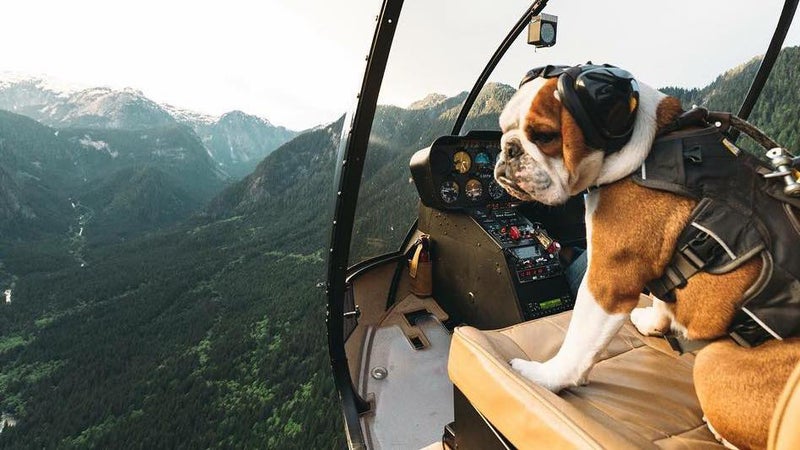
Find Yourself a Good Wingman
π˙≤˙≥‘πœ∫⁄¡œs, filmmaking, life‚Äîeverything is better with a good buddy, be it human or canine. ‚ÄúBentley‚Äôs level of stoke for anything outdoors is pretty awesome. He has over 400 hours of flying now,‚Äù says Friesen. ‚ÄúRecently I looked over my shoulder and his face was pressed against the glass watching the sunset. I don‚Äôt know if he enjoys it, but he sure looks like he does.‚Äù
Freakishly smooth footage. Smart-capture superpowers. Battle-tested and waterproof without a housing. This is , the most advanced GoPro ever. With HyperSmooth stabilization, you‚Äôll get gimbal-like video‚Äîwithout the gimbal. A new intelligent photo mode delivers the best, most brilliant images automatically. And now with live streaming and the GoPro app, you can share every amazing moment as you live it. HERO7 Black takes GoPro performance‚Äîand your photos and videos‚Äîto a whole new level. ¬Ýto learn more.

